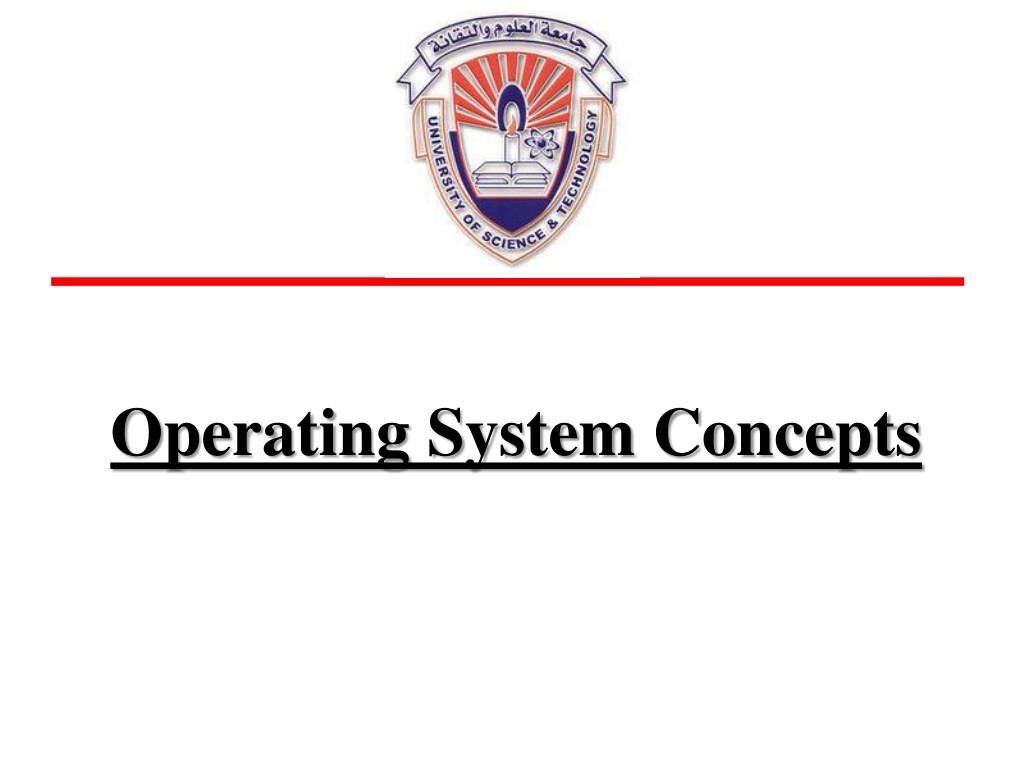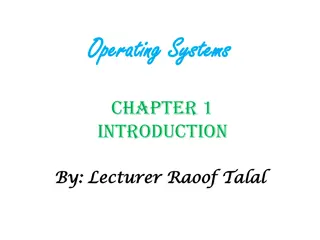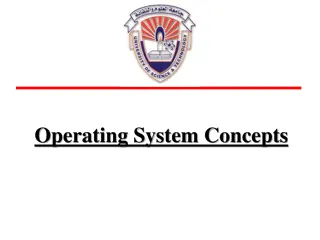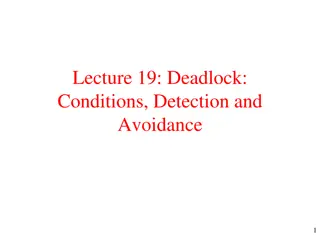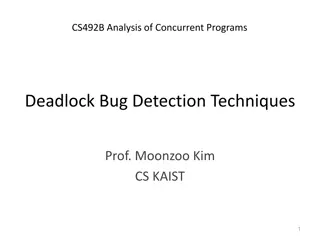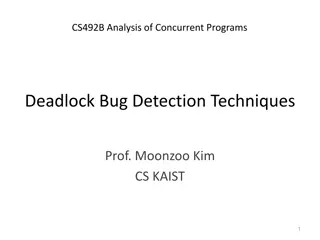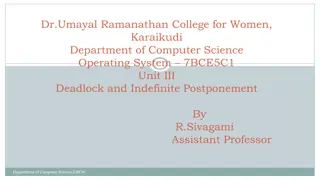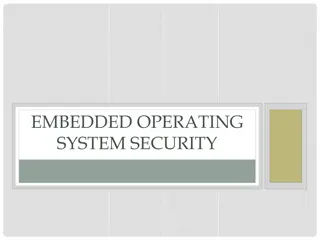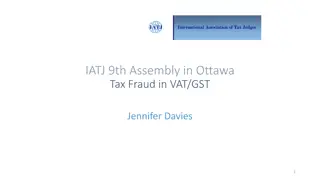Understanding Deadlock Avoidance in Operating System Concepts
Deadlock Avoidance is a critical concept in operating system design to prevent system resources from entering a deadlock state. By requiring additional information about resource requests and utilizing algorithms like the banker's algorithm, systems can dynamically allocate resources to avoid circular wait conditions and potential deadlocks. Resource-allocation graph algorithms play a key role in this process, converting claim edges into request edges and assignments to ensure efficient resource management.
Download Presentation

Please find below an Image/Link to download the presentation.
The content on the website is provided AS IS for your information and personal use only. It may not be sold, licensed, or shared on other websites without obtaining consent from the author. Download presentation by click this link. If you encounter any issues during the download, it is possible that the publisher has removed the file from their server.
E N D
Presentation Transcript
Lecture 8 Lecture 8 C Deadlocks (cont..) References for Lecture: Abraham Silberschatz, Peter Bear Galvin and Greg Gagne, Operating System Concepts, 9th Edition, Chapter 7 2
Contents of Lecture System Model Deadlock Characterization Methods for Handling Deadlocks Deadlock Prevention Deadlock Avoidance Deadlock Detection Recovery from Deadlock
Deadlock Avoidance An alternative method for avoiding deadlocks is to require additional informationabout how resources are to be requested. For example, in a system with one tape drive and one printer, the system might need to know that process P will request first the tape drive and then the printer before releasing both resources, whereas process Q will request first the printer and then the tape drive. With this knowledge of the complete sequence of requests and releases for each process, the system can decide for each request whether or not the process should wait in order to avoid a possible future deadlock.
Deadlock Avoidance Requires that the system has some additional a priori information available: Simplest and most useful model requires that each process declare the maximum number of resources of each type that it may need The deadlock avoidance algorithm dynamically examines the resource allocation state to ensure that there can never be a circular wait condition Resource allocation state is defined by the number of available and allocated resources, and the maximumdemands of the processes
Deadlock Avoidance Avoidance Algorithms: Single instance of a resource type Use a resource-allocation graph algorithm Multiple instances of a resource type Use the banker s algorithm
Resource-allocation graph algorithm In addition to the request and assignmentedges already described, introduce a new type of edge, called a claim edge. A claim edge Pi Rj indicates that process Pi may request resource Rj at some time in the future. This edge resembles a request edge in direction but is represented in the graph by a dashed line. The algorithm: Claim edge converts to request edge when a process requests a resource Request edge converted to an assignment edge when the resource is allocated to the process When a resource is released by a process, assignment edge reconverts to a claim edge
Resource-allocation graph algorithm To illustrate the algorithm. An unsafe state in a resource-allocation graph
Bankers algorithm When a new process enters the system, it must declare the maximum number of instances of each resource type that it may need. When a user requests a set of resources, the system must determine whether the allocation of these resources will leave the system in a safe state. If it will, the resources are allocated; Otherwise, the process must wait until some other process releases enough resources.
Bankers algorithm Data structures for banker s algorithm Let n is the number of processes in the system and m is the number of resource types: Available: A vector of length m indicates the number of available resources of each type. If Available [j] equals k, then k instances of resource type Rj are available. Max: An n m matrix defines the maximum demand of each process. If Max[i][j] equals k, then process Pi may request at most k instances of resource type Rj .
Bankers algorithm Data structures for banker s algorithm Let n is the number of processes in the system and m is the number of resource types: Allocation: An n m matrix defines the number of resources of each type currently allocated to each process. If Allocation[i][j] equals k, then process Pi is currently allocated k instances of resource type Rj . Need: An n m matrix indicates the remaining resource need of each process. If Need[i][j] equals k, then process Pi may need k more instances of resource type Rj to complete its task. Note that Need[i][j] equals Max[i][j] Allocation[i][j]
Bankers algorithm Safety algorithm 1. Let Work and Finish be vectors of length m and n, respectively. Initialize: Work = Available Finish [i] = falsefor i = 0, 1, , n- 1 2. Find an i such that both: (a) Finish [i] = false (b) Needi <= Work If no such i exists, go to step 4 3. Work = Work + Allocation i Finish[i] = true go to step 2 4. If Finish [i] == true for all i, then the system is in a safe state
Bankers algorithm Example with a Banker Consider a banker with 3 clients (A, B, C) Each client has certain limits (totaling 20 units) The banker know that max credits will not be used at once, so keeps only 10 units Total: 10 units free: 3 units Client declare maximum credits in advance. The banker can allocate credits provided no unsafe state is reached.
Bankers algorithm Example with a Banker Safe state
Bankers algorithm Example with a Banker Unsafe state
Bankers algorithm Example To illustrate the use of the banker s algorithm, consider the following: 5 processes P0 through P4; 3 resource types: A (10 instances), B (5instances), and C (7 instances) Snapshot at time T0: The content of the matrix Need is defined to be Max Allocation and is as: The system is in a safe state since the sequence < P1, P3, P4, P2, P0> satisfies safety criteria
Bankers algorithm Example Suppose now that process P1 requests one additional instance of resource type A and two instances of resource type C, so Request1 = (1,0,2) (3,3,2). Executing safety algorithm shows that sequence < P1, P3, P4, P0, P2> satisfies safety requirement Exercise: Can request for (3,3,0) by P4 be granted? Can request for (0,2,0) by P0 be granted?
Deadlock Detection Allow system to enter deadlock state, after that used: Detection algorithm Recovery scheme
Deadlock Detection Single Instance of Each Resource Type If all resources have only a single instance, then can define a deadlock detection algorithm that uses a variant of the resource-allocation graph, called a wait-for graph. An edge from Pi to Pj in a wait-for graph implies that process Pi is waiting for process Pj to release a resource that Pi needs. An edge Pi Pj exists in a wait-for graph if and only if the corresponding resource allocation graph contains two edges Pi Rq and Rq Pj for some resource Rq . As before, a deadlock exists in the system if and only if the wait-for graph contains a cycle.
Deadlock Detection Several Instances of a Resource Type The algorithm employs several data structures that are similar to those used in the banker s algorithm: Available: A vector of length m indicates the number of available resources of each type. Allocation: An n m matrix defines the number of resources of each type currently allocated to each process. Request: An n m matrix indicates the current request of each process. If Request[i][j] equals k, then process Pi is requesting k more instances of resource type Rj
Deadlock Detection Detection algorithm 1. Let Work and Finish be vectors of length m and n, respectively. Initialize: Work = Available. For i = 0, 1, ..., n 1, if Allocation i 0, then Finish[i] =false. Otherwise, Finish[i] = true. 2. Find an index i such that both a. Finish[i] == false b. Requesti Work If no such i exists, go to step 4.
Deadlock Detection Detection algorithm 3. Work = Work + Allocation i Finish[i] = true Go to step 2. 4. If Finish[i] == false for some i, 0 i < n, then the system is in a deadlocked state. Moreover, if Finish[i] == false, then process Pi is deadlocked.
Deadlock Detection Example Check if there is any sequence of allocation by which all current request can be met. If so, there is no deadlock.
Deadlock Detection Example If P3 change the request to (2 1 0 0) as following. P3 can be satisfied, so, no deadlock.
Deadlock Detection Example Consider the following: Claim that the system is not in a deadlocked state, if execute t the sequence <P0, P2, P3, P1, P4>.
Deadlock Detection Example Suppose now that process P2 makes one additional request for an instance of type C. The Request matrix is modified as follows: A deadlock exists, consisting of processes P0, P1, P2, P3, and P4.
Recovery from Deadlock There are two options for breaking a deadlock. One is simply to abort one or more processes to break the circular wait. The other is to preempt some resources from one or more of the deadlocked processes.
Recovery from Deadlock Process Termination To eliminate deadlocks by aborting a process, one of two methods used: Abort all deadlocked processes Abort one process at a time until the deadlock cycle is eliminated Many factors may affect which process is chosen, including: 1. What the priority of the process is 2. How long the process has computed and how much longer the process will compute before completing its designated task 3. How many and what types of resources the process has used (for example, whether the resources are simple to preempt) 4. How many more resources the process needs in order to complete 5. How many processes will need to be terminated 6. Whether the process is interactive or batch
Recovery from Deadlock Resource Preemption Preempt some resources from processes and give these resources to other processes until the deadlock cycle is broken. If preemption is required to deal with deadlocks, then three issues need to be addressed: 1. Selecting a victim: Which resources and which processes are to be preempted? As in process termination, must determine the order of preemption to minimize cost. 2. Rollback: Checkpoint states and then rollback. 3. Starvation: same process may always be picked as victim, include number of rollback in cost factor
